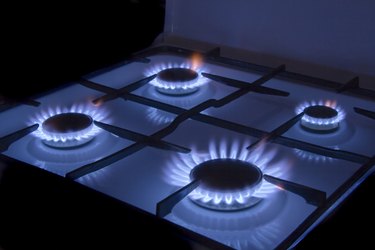
The flames from a natural gas stove can tip you off to a possible hazard. If you see orange flames in your gas stove, you may need to clean or adjust the burners. The orange color alerts you to improper combustion in your stove, which may emit unsafe levels of carbon monoxide gas.
Stove Combustion Principles
Video of the Day
For complete combustion to occur, a gas stove must supply the proper amount of fuel that mixes with the correct balance of oxygen, which yields carbon dioxide, or CO2. But when the fuel-oxygen mixture is imbalanced, combustion is incomplete and carbon monoxide, or CO, is the byproduct.
Video of the Day
The flame color is proportional to the heat intensity — hotter flames, which result from the proper fuel-oxygen ratios and achieve complete combustion, are blue. When the fuel-oxygen mixture is imbalanced, however, the flames have cooler pockets because the fuel isn't consumed properly. The result is orange flames.
Causes of Orange Flames in Your Gas Stove
An imbalance in the fuel-oxygen mixture can have a variety of causes. Gas burner orifices may become clogged from a buildup of soot, which results in an uneven supply of fuel to the burner. When the flame burns the soot, the resulting incandescence is orange.
The wrong orifice may be installed for the type of gas you are using; liquid propane and natural gas don't have the same air-to-fuel requirements. The air shutter might be sized improperly or might be damaged, preventing the correct amount of oxygen to mix with the fuel. With an insufficient oxygen supply, only some of the gas can ignite in a hotter blue flame, and the rest is wasted in a cooler orange flame.
Orange Flames in Your Gas Stove May Be a Red Flag
Carbon monoxide gas is a combustion byproduct. Gas stoves that produce blue flames are typically emitting safe levels of CO when used for normal cooking tasks. Orange flames, however, are a red-flag alert that elevated CO levels may be present.
CO poisoning causes flu-like symptoms, such as headache, dizziness and nausea. In extreme cases, CO earns its name as the silent killer because it may deliver a lethal dose to unsuspecting victims through its colorless and odorless presence.
A gas stove is not a vented appliance and should never be used for home heating. Even a blue flame emits some CO, which can accumulate to dangerous levels in the absence of ventilation.
How to Fix Orange Flames in Your Gas Stove
Correcting an imbalanced fuel-oxygen mixture isn't a DIY task. Working with gas appliances is potentially dangerous. Instead, call a qualified gas appliance technician to inspect the stove and diagnose the problem. The technician may need to clean the gas burner orifices, adjust the air shutter, or replace an improperly sized burner. You can also protect your family going forward by installing carbon monoxide detectors that alert you to unsafe CO levels.